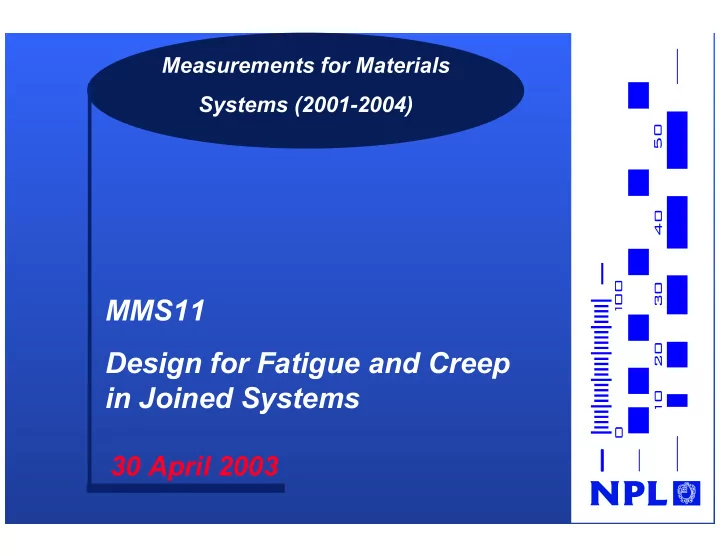

Measurements for Materials Systems (2001-2004) MMS11 Design for Fatigue and Creep in Joined Systems 30 April 2003
Project outline � Evaluation of design methods for predicting deformation and failure bolted and adhesively bonded joints � Monotonic � Creep � Fatigue � Development and evaluation of models for describing deformation and failure of � Tough adhesives � Fibre-reinforced laminates � Determination of model parameters for different materials � Comparison of predictions with measurements using a selected joint geometry
Geometry of bonded study joint Geometry of bonded study joint web 15 mm flange 150 mm 15 mm Adhesive base plate thickness = 0.5 mm 101.6 mm 35 mm 50 mm 15 mm 15 mm 15 mm 300 mm All parameter changes were based on this starting geometry
Bonding options Bonding options Filled “Bermuda Triangle” Unfilled “Bermuda Triangle” (basic geometry)
Materials Materials � Rubber Toughened Epoxy Adhesives � XD4601 (Dow Chemicals) and DP460 (3M) � Adherends � 2014 aluminium alloy � GRP – UD + biaxial woven fabric/epoxy (SP Systems) � Surface Treatment � Aluminium - chromic acid etched � Composite - grit blasted � Systems � Aluminium/XD4601 and GRP/DP460
Autoclave Moulding GRP Flanges Autoclave Moulding GRP Flanges Problems: Autoclave curing + spring-back
Evaluation of models for tough adhesives � Monotonic loading � Elastic-plastic models � Von Mises � Linear Drucker-Prager � Exponent Drucker-Prager � Cavitation � Application described in a Smart Manual � Creep loading � Model based on non-linear creep in plastics � Application to FE analysis
Deformed Mesh Superimposed on Original Mesh Deformed Mesh Superimposed on Original Mesh Transverse Tension Transverse Tension A B C
Contour Plot of S 11 Stress at Predicted Failure Load Contour Plot of S 11 Stress at Predicted Failure Load (contours are shown for the adhesive region only) (contours are shown for the adhesive region only)
Full 3- -D Model D Model Full 3 Mesh Discretisation Discretisation, Applied Load and Supports , Applied Load and Supports Mesh A C B ½ mesh – direct tension full mesh - transverse and 45° tension (sufficient) (necessary)
Experimental Arrangement Experimental Arrangement
Recent publications and reports Recent publications and reports � Publications and reports � Geometric and Material Property Effects on the Performance of Adhesive T-Joints, NPL Measurement Note MATC(MN)29. � Geometric and Bolt Position Effects on the Performance of Bolted T-Joints, NPL Measurement Note MATC(MN)30. � Finite Element Assessment of Geometric and Material Property Effects on the Strength and Stiffness of Bonded and Bolted Joints, NPL Report MATC(A)124. � Prediction of Deformation and Failure of Rubber-toughened Adhesive Joints submitted to Int. J. Adhesion and Adhesives � Smart Manual � Deformation and Failure of Rubber-Toughened Adhesive Joints
Recommend
More recommend